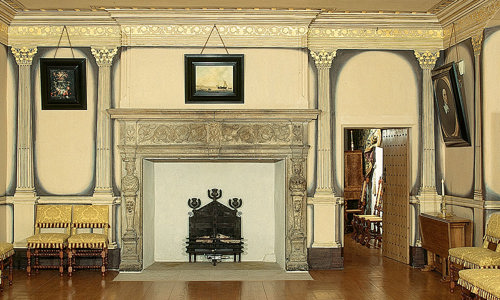History
Doune has a long history of fortification. A Roman fort is nearby, and the masonry and earthworks of the present castle probably include parts of an earlier castle that stood here.
But the way the castle looks today is largely down to ‘Scotland’s uncrowned king’. Doune was the seat of Robert Stewart, the 1st Duke of Albany and Governor of Scotland. He acquired the castle in 1361, when he married Margaret Graham, Countess of Menteith.
A royal retreat
Albany was the younger brother of Robert III, who was politically weak and physically infirm after an injury.
Albany became governor and the effective ruler of the kingdom – for all but two years – from 1386 until his death in 1420. When the future king, James I, was taken prisoner in England in 1406, Albany was left as both Governor and Guardian of Scotland.
Yet Doune only officially became a royal castle after the death of both Albany and his son Murdoch, who was executed by James I on his return to Scotland in 1424.
Doune provided secure lodgings, but it seems neither as well organised nor as comfortable as Edinburgh Castle or Stirling Castle. There’s a sense that what we see today is only half a castle. Whether Doune was completed, and what might have been lost, is unclear.
Doune’s role as royal retreat effectively came to an end in 1603, when James VI left for London, to become James I of England.
Built to impress
Abbot Bower of Inchcolm, who lived at the same time as Albany, described the duke as a ‘big spender’. No expense was spared on Doune – even in its ruined state, the castle inspires awe in visitors.
Making a show of one’s wealth and status was vital to maintain authority and good governance in Albany’s age. Doune was fitting accommodation for a man of royal blood in 14th-century Scotland.
Castle living quarters
Doune’s great hall impresses most. The cathedral-like room has a minstrels’ gallery and a distinctive central hearth. Standing inside, you can see why Albany was noted for his ‘large tabling and belly cheer’.
The gatehouse provided the duke and duchess with private apartments over a well-defended entry, which still has its iron yett and drawbar.
Inside is the Duke’s Hall, which was restored in 1883 as part of the renovations ordered by the Earl of Moray.
The Duke’s Hall features a:
- musicians’ gallery
- double fireplace
- carved oak screen
At the other end of the great hall is the kitchen tower. The tower’s lower levels may be part of an earlier castle that pre-dates the 14th-century fortification.
The kitchen tower housed:
- an impressive kitchen
- two floors of high-status chambers
Mystery of the missing ranges
Doune appears to be missing something – its south and west ranges of buildings.
Projecting ‘tusks’ on the kitchen tower and impressive windows in the south wall tell us that either the two ranges:
- were planned but not completed
- did exist at one stage but were later taken down, leaving very little trace
Historical records show that Albany entertained great numbers of lords and ladies. This supports the belief that Doune Castle is not as big as it once was.
Architectural analysis and archaeological excavation at Doune hint at earlier phases of fortification. The courtyard’s odd shape, the ill-fitting kitchen tower and the limited accommodation all suggest that there is more to be discovered here.















